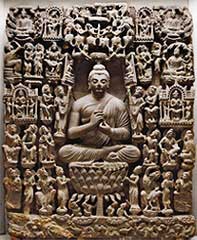The home of the Gandhara school of art is the territory in and around Peshawar in northwestern India. The best of the Gandhara sculpture was produced during the first and second centuries A.D. It originated during the reign of Indo-Greek rulers but the real patrons of this school of art were the Sakas and the Kushanas, particularly Kanishka. Gandhara art was a blend of Indian and Graeco-Roman elements.
 |
| Gandhara Art |
- Moulding human body in a realistic manner with minute attention to physical features like muscles, moustache and curtly hair.
- Thick drapery with large and bold fold lines.
- Rich carving, elaborate ornamentation and symbolic expressions.
 |
| Gandhara Art |
– and the evolution of an image of Buddha.
A large number of monasteries were also built from first to fourth centuries A.D. Ruins of about fifteen monasteries were found in and around Peshawar and Rawalpindi. The Buddhist stupas erected during this period had Graeco-Roman architectural impact. The height of the stupa was raised and ornamentation was added to the structure of the stupa. These changes made the stupa more attractive.
Mathura School of Art
The school of art that developed at Mathura in modern Uttar Pradesh is called the Mathura art. It flourished in the first century A.D. In its early phase, the Mathura school of art developed on indigenous lines. The Buddha images exhibit the spiritual feeling in his face which was largely absent in the Gandhara school. The Mathura school also carved out the images of Siva and Vishnu along with their consorts Parvathi and Lakshmi. The female figures of yakshinis and apsaras of the Mathura school were beautifully carved.
Successors of Kanishka and end of Kushana Rule
The successors of Kanishka ruled for another one hundred and fifty years. Huvishka was the son of Kanishka and he kept the empire intact. Mathura became an important city under his rule. Like Kanishka he was also a patron of Buddhism. The last important Kushana ruler was Vasudeva. The Kushana empire was very much reduced in his rule. Most of his inscriptions are found in and around Mathura. He seems to have been a worshipper of Siva. After Vasudeva, petty Kushan princes ruled for sometime in northwestern India.
